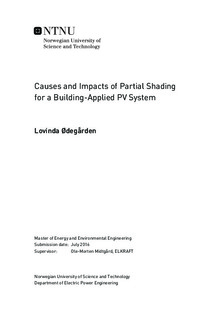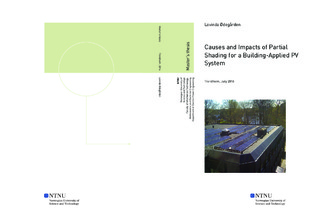| dc.description.abstract | The world as we know it today is full of technical equipment that requires energy of some sort, let it be oil, gas or electricity. With an increasing growth of the earth s population, as well as a boost in the general standard of living, it is certain that the total energy need will increase. To meet these demands one must utilize all the research available to develop the new era renewable energy and environmentally friendly technology. Solar energy is without a doubt one of the most certain sources of energy that will become a large supplier of consumer energy in the future. Thus it is important to keep on researching new ways to increase the efficiency of today s solar photovoltaic (PV) applications and keep lowering the cost of such technology.
This master s thesis has studied a building-applied PV system in Norway and investigated how well the technology performs during partial shading conditions. The PV system studied in this thesis is that of Powerhouse Kjørbo in Sandvika, near the capital Oslo. Powerhouse Kjørbo is an old rehabilitated office building and is Norway s first energy-positive office building, in its third year of operation. The building, consisting of two blocks, is meant to produce more energy than it uses for materials, production, operation, renovation and demolition during the whole of its lifetime. The energy is produced by solar panels installed at the two rooftops and on the top of a nearby parking complex.
The work began with gaining information about and understanding of the Powerhouse Kjørbo PV system and how it might be affected by partial shading. Prior to performing measurements and experimental and simulation studies of the Powerhouse Kjørbo system, a week of inspection was done at the site. Soiling of the modules by bird droppings and other pollution particles was observed as a potential factor for losses It was also found sources for cast shadows among others a vent pipe, a steel safety wire and a mussel shell lying on the surface. The findings became the background for the conducted shading experiments and simulations. The results from the experimental and simulation study were then used to estimate the impacts of selected cast shadows, and finally, on-site measurements at Powerhouse Kjørbo were conducted to compare to the previous findings.
It was found that cleaning of strings of PV modules resulted in an increased daily energy yield by up to 11 \%, compared to uncleaned modules under the same environmental conditions. It was also found that all of the identified sources of partial shading had a visible impact corresponding well to what was found during the experimental and simulation studies. When analyzing the shading impacts, the I-V curve has been shown to be most useful, where the main indicator of reduced potential power production is the short-circuit current. The simulation models have been verified by real-life measurements, and proven to need some upgrades to represent a fully realistic model of a PV module or system. When measurements were performed at the PK system, it was found that the worst drop in power occurs when shading modules on their short edge. The partial shading source that had the greatest impact was shown to be an exaust vent, causing a power reduction of nearly 20 \% on a string level. | |

